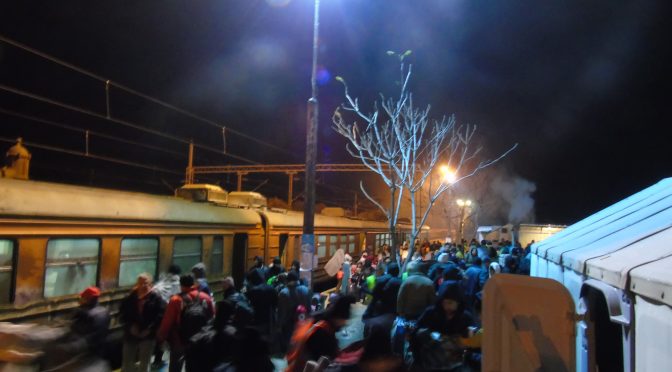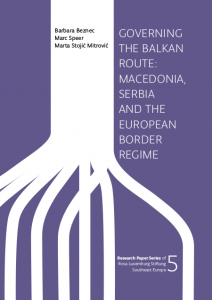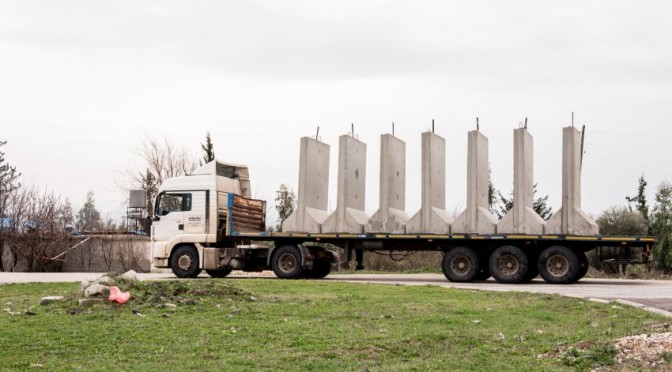It happened as it was to be expected: Four years of standing on the sidelines have resulted in a catastrophe. 40,000 human beings, penned up in hopelessly overcrowded EU-hotspot centres like Moria on Lesvos Island, living under squalid living and hygienic conditions, will soon face the deadly disease. European countries close their borders and enforce social distancing in order to curb the spread of the pandemic. But the Greek health system, already severely weakened by austerity policies and the economic crisis, is in no condition to guarantee the medical care for refugees once the pandemic starts spreading widely. Yet still, the EU does not answer the numerous appeals to evacuate the centres and to bring those affected to safety. Internment is the EU’s answer.
REFUGEES WELCOME! DON’T SHOOT! STOP EUROPES’S TREND TOWARDS FASCISM! weiterlesenArchiv der Kategorie: EU
Governing the Balkan Route: Macedonia, Serbia and the European Border Regime
Together with the Rosa Luxemburg Stiftung Southeast Europe, bordermonioring.eu e.V. recently published a report on the Balkan Route:
The growth and development of transit migration along the Balkan route in 2015 and 2016 highlighted the major role Macedonia and Serbia played, not merely as the main countries of passage, but as important buffer areas within the framework of the European border regime. This research paper first examines the development and transformations of Macedonian and Serbian national migration policies and legislation in the past two decades in the light of the EU accession process. It identifies the key historical and geopolitical factors that significantly shaped them, as well as the distinct strategies the two countries pursued in coping with often countervailing EU demands, local socio-political considerations and actual migration movements and practices. The paper proceeds to analyze the gradual establishment of a formalized corridor through the Balkans by tracing the ways in which Macedonia and Serbia strategically positioned themselves in how they governed the transit migration through their territory, dynamically shifting between humanitarianism and securitization throughout the time before the formalized corridor emerged, during its existence, in the process of its closure, and after it was shut down.
Der EU-Türkei–Deal und seine Konsequenzen [Update: 9]
Nachdem am Freitag, den 18. März 2016 der EU-Türkei-Deal beschlossen wurde, wird er nun mit Hochdruck umgesetzt. In diesem Artikel, den wir laufend aktualisieren werden, verfolgen wir die Umsetzung mit einem groben Fokus auf Griechenland und die Ägäis.
Der EU-Türkei–Deal und seine Konsequenzen [Update: 9] weiterlesen
Panik vor dem Frühling: EU bei „managing the refugee crisis“ unter Zeitdruck
Beim EU-Gipfel am 18./19. Februar wird die “Bewältigung der Flüchtlingskrise” weiter im Mittelpunkt stehen. Der Joint Action Plan mit der Türkei und der Druck auf Griechenland zur besseren Zusammenarbeit hat noch nicht die erwünschte Wirkung gezeigt. Zwar spricht die Kommission in ihrer am 10.2. veröffentlichten Bestandsaufnahme über die Implementierung der im Dezember beschlossenen Maßnahmen von “großen Erfolgen”. Außer der Steigerung der Registrierungszahlen und abgenommenen Fingerabdrücke in Italien und Griechenland, bestätigt der Bericht jedoch eher eine stockende Umsetzung und wenig politischen Willen der Mitgliedsstaaten.
Panik vor dem Frühling: EU bei „managing the refugee crisis“ unter Zeitdruck weiterlesen
Turkey: Negotiating the “Harmonization”
Article by Mathias Fiedler, Photos by Charlotte Schmitz
One can recognize the negotiation process between the EU and Turkey in the so called “harmonization packages“ which were aimed to harmonize Turkish law with the European Union legislation[1]. The EU is more than ever before eager to collaborate with Turkey and both “partners“ agreed on a “joint action plan” concerning migration [2]. Turkey, being the most important transit country to Europe, is one of the “focal points of the EU’s externalization strategy” and the EU promised three Billion EUR for the reception of refugees. But while the EU-countries still are in disagreement on how to raise that sum, Erdoğan already stated that this amount of money won’t be enough anyway. However, the closer EU-Turkey collaboration has already had negative effects for refugees in Turkey: Refugee rights organizations stated that “more detention“ and “less reception” was one of the first consequences of the agreement [3].



![Der EU-Türkei–Deal und seine Konsequenzen [Update: 9]](https://bordermonitoring.eu/wp-content/uploads/2016/03/CfC2hdGWwAEjNKp.jpg-large-672x372.jpg)
